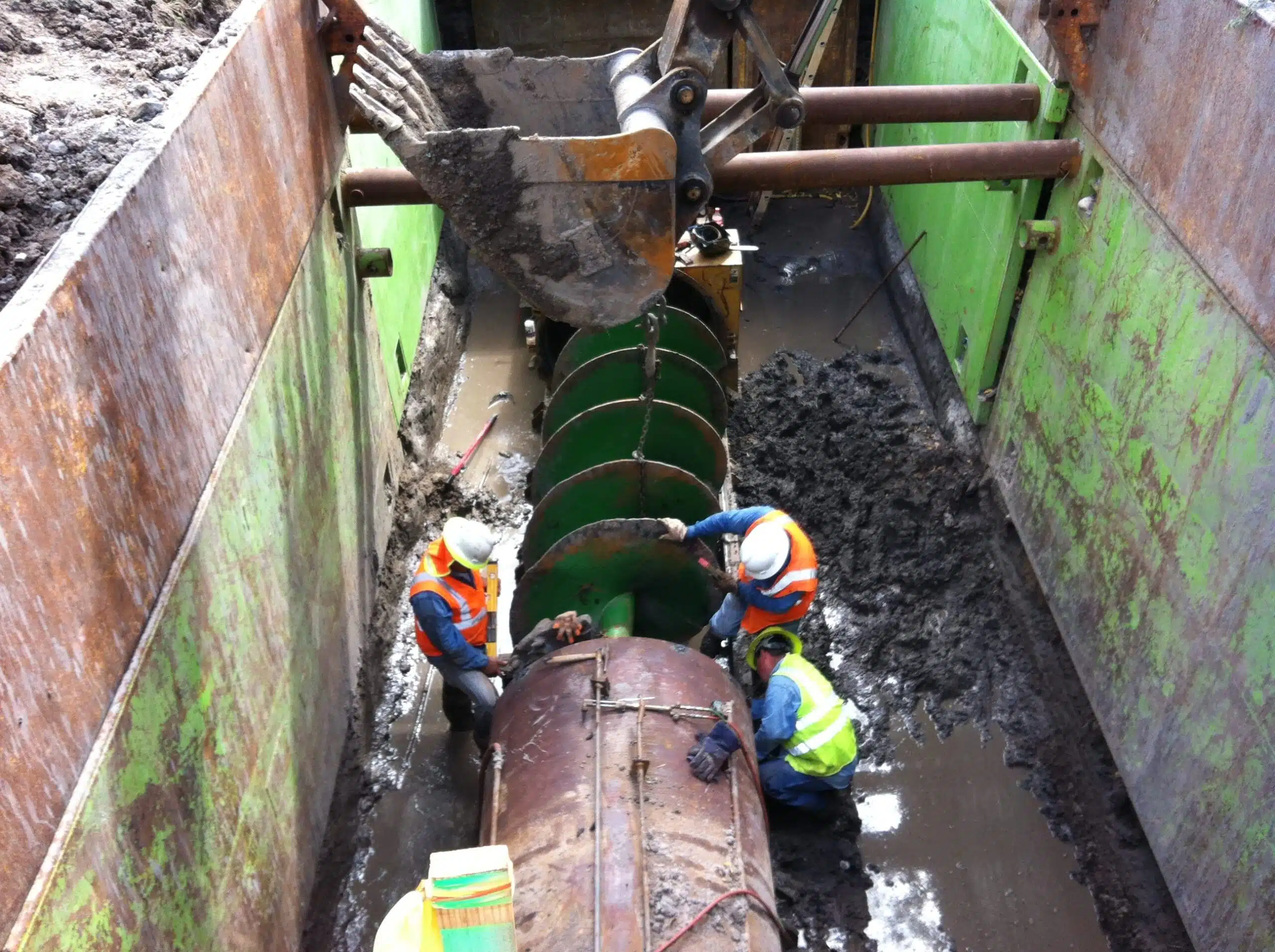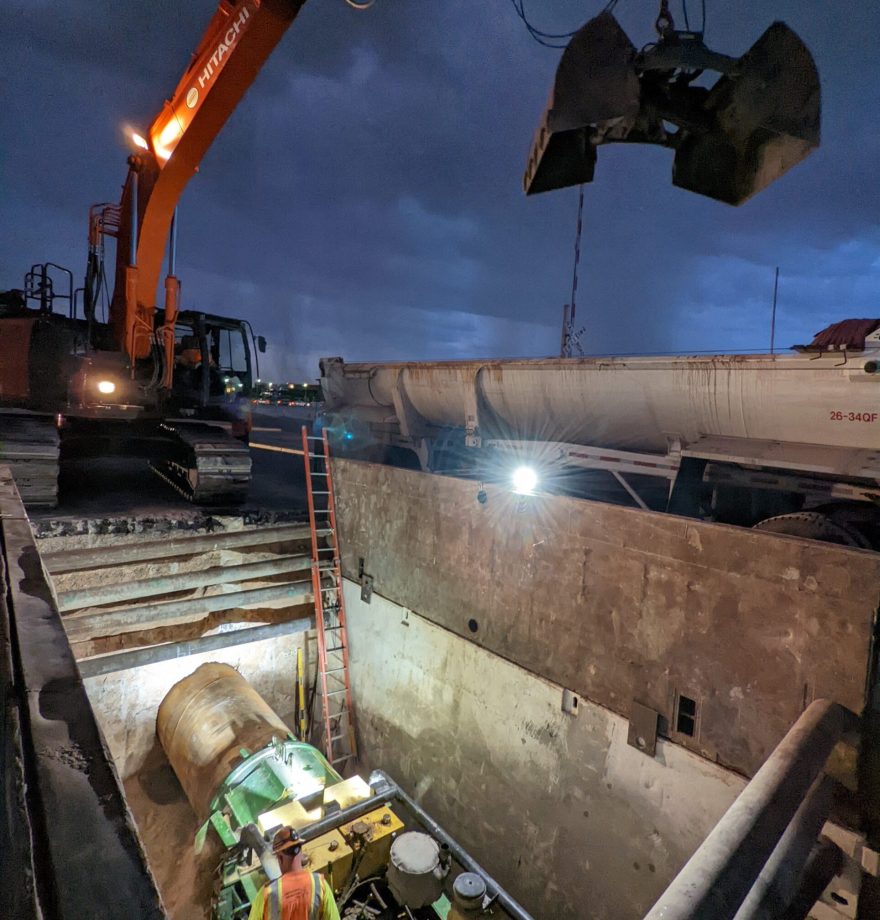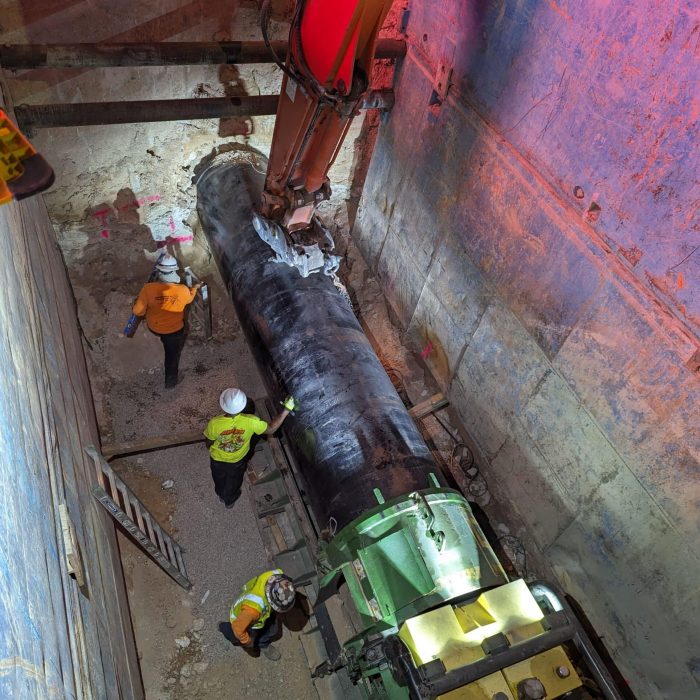- March 6, 2024
- Perspectives
Horizontal Auger Boring: The Tried-and-True Trenchless Technology Method


Tyler Kay, PE
Water/Wastewater Project Manager

Marty Paris, PE
Trenchless Technology Practice Leader
First used in 1936, horizontal auger boring, also known as jack and bore, is one of the most common trenchless technology methods. This method excavates boreholes beneath the surface and allows contractors to install new pipes while minimizing above-ground impact. Read more to learn about the pros and cons of horizontal auger boring and why it is a staple in the trenchless technology sector.
What is Horizontal Auger Boring?
Horizontal auger boring (HAB) is a trenchless excavation method that requires digging into the ground to create an access and receiving pit for the boring equipment. After digging the pits, contractors insert a steel casing into the ground with an auger screw attached—extracting the soil as the auger and casing advance.
A Low-Cost and Accessible Boring Method
HAB is an established, tried-and-true method within the field of trenchless technology. Due to its commonality and familiarity with contractors, it has become one of the most inexpensive and low-tech trenchless methods.
Many contractors own the equipment needed to execute this trenchless method, which means they don’t need to invest in specialized machinery or training for their workers. This primarily benefits local contractors since they may need access to specialized equipment for other trenchless methods, such as microtunneling.
A Dependable Trenchless Process
The typical pipe lengths for HAB can be anywhere from 20 feet to 500 feet, and the diameter anywhere from eight to 100 inches. HAB also utilizes steel casing pipes to encase the carrier pipe. For example, an eight-inch pipe will have a 16-inch steel casing pipe. The auger bore installs the steel casing pipe first, and then the eight-inch carrier pipe is pushed through with casing spacers.
The diameter of the casing pipe will vary based on the material of the carrier pipe and joint systems. For example, some installations need four to six inches of space between the pipe and steel casing wall so the pipe and its spacers can fit into the steel casing. In some cases, contractors may run multiple pipes through one casing—meaning the casing needs to be large enough to fit them all.
The length of the carrier pipe joints being installed plays a significant role in determining the length of the launching pits’ size—the longer the joints, the longer the pit needs to be. The diameter and the length of the bore also impact the launching pit size. . For example, if a contractor wants to install a 20-foot pipe, they must dig a 25-foot-long pit—giving enough room for the equipment and the pipe. The pit depth can vary, but it must be level with the elevation of the pipe installation.

When Should Horizontal Auger Boring be Used?
Unlike other trenchless technology methods, HAB should only be used to install new pipes instead of rehabilitating old pipes. It is ideal for short distances—especially when digging under road crossings, wetlands, creeks, trees, or any other structures that would be disturbed by open-cut or excavation methods.
Installing Pipes in Soft Soils
Soft rock, clay, and stiff sands are ideal for HAB since the auger flights can easily remove these materials. However, it may be difficult or infeasible to execute HAB in harder soils or rock.
Hiring a geotechnical engineer to investigate the area before boring helps determine the needed depth of the pits and pipe installation. Geotechnical engineers can ascertain the soil profile, helping contractors avoid surprises. Soils change at certain depths, and contractors can encounter split-face soil conditions—meaning that there could be soft soil directly next to hard rock, creating a costly disaster for boring equipment. Most often, geotechnical engineers will encourage contractors to bore deeper than their initial expected installation depth to avoid such expensive mishaps.
Working within Environmentally Sensitive Areas

HAB may be the best solution to minimize environmental impacts. For example, an owner must procure a 404 permit before crossing a wetland. HAB may allow owners to bypass securing the permit since the boring occurs under the area, not through.
Additionally, no drilling fluids are needed to execute HAB. This is especially ideal when working near railroads or protected wildlife areas, which do not allow fluids for boring or construction due to concerns about fracking and water seepage.
The Challenges of HAB Installation
As mentioned before, one of the benefits of HAB is accessibility due to the low-tech methods and equipment—but this is also one of HAB’s biggest challenges. Keeping the bore on a horizontally and vertically steady track can be difficult, especially when dealing with long pipe crossings. Once the bore veers off course, it is nearly impossible to re-right it since the soil is already extracted. This is why it is particularly risky to use HAB for longer distances.
However, there are ways to ensure the bore stays on track. One method is to pull the auger out after a few feet and then use a laser level to survey if the bore is on the right path. This method can take time, so many contractors may choose to forgo it and proceed with other instruments, such as a water leveler. To mitigate the risks of the bore running off track, contractors can drill a small pilot hole through the desired pipe installation path and then guide the auger along the established path. Like the laser level process, the pilot hole method is time-consuming, but it is also one of the most reliable and accurate methods.
Another challenge with HAB is that the operators cannot see in front of them as they are boring. They could encounter an obstruction, such as a gas line, and push through, causing a leak or even an explosion. The lack of visibility when boring requires operators to have a thorough knowledge of the project’s underground utility map to better understand potential obstructions and how to avoid them.
Even though trenchless technologies continue emerging and advancing, HAB remains a favorite among contractors. Whether the project involves tried-and-true HAB or other methods like pipe bursting or horizontal directional drilling, Kimley-Horn’s specialists bring a wealth of experience to every trenchless technology project.
About the Authors

Tyler Kay, PE
Tyler has more than 13 years of experience as a project manager, project engineer, and discipline task leader on water and wastewater infrastructure and rehabilitation projects. His experience includes planning, design, and construction phase services for water, sewer, and reclaimed water projects across the western half of the US. His trenchless design experience is diverse, including horizontal auger boring, horizontal directional drilling, hand tunneling, micro tunneling, pipe bursting, slip lining, and cured-in-place-pipe.

Marty Paris, PE
Marty is a Trenchless Technology Practice Leader with more than 30 years of experience in the design of water and wastewater infrastructure and rehabilitation projects. He has worked on over 200 miles of large- and small-diameter water and wastewater pipeline projects, ranging from six-inches to 120-inches and has assisted multiple municipalities with planning, design, and construction phases. He has experience resolving a variety of project challenges ranging from the operations level to the administrative level. His experience includes 200,000 linear feet of trenchless replacement/rehabilitation methods, including cured-in-place, pipe bursting, horizontal directional drilling, microtunneling, fold and form, slip lining, tunneling, and horizontal auger boring.
